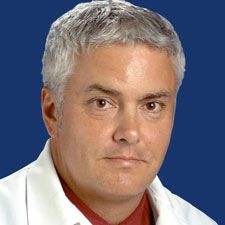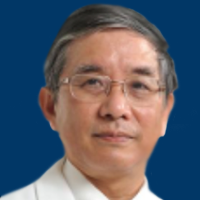Sequencing Therapies for mTNBC
EP: 1.Standard of Care for Early-Stage TNBC
EP: 2.Role of pCR in Early Stage TNBC Management
EP: 3.Key Trials in ICI-Based Therapy for Early Stage TNBC
EP: 4.Early Stage TNBC: Phase 3 IMpassion031 Study
EP: 5.Role of Immune Checkpoint Inhibitor-Based Therapy in ES TNBC
EP: 6.ICI-Based Therapy in TNBC: Immune-Related Adverse Events
EP: 7.Emerging Data on Biomarkers in ES TNBC
EP: 8.Current Trials for Treatment of Early Stage TNBC
EP: 9.Standard of Care for Metastatic TNBC
EP: 10.KEYNOTE-355 Trial in mTNBC
EP: 11.Testing for PD-L1 Expression in mTNBC
EP: 12.Standard of Care for BRCA+ mTNBC
EP: 13.Sequencing Therapies for mTNBC
EP: 14.Phase 3 ASCENT Trial in mTNBC
EP: 15.Phase 3 ASCENT Trial in mTNBC: Managing Adverse Events
EP: 16.Future Directions for Treatment of TNBC
Joyce A. O’Shaughnessy, MD: Before we go on to the new survival data with sacituzumab govitecan that came out of ESMO [European Society for Medical Oncology Congress], which I do want to spend some time on, let’s stop here for a second and summarize.
Let’s go around, so each of us can summarize how you in general approach the first- and second-line treatment in the very heterogeneous group of patients who are triple-negative breast cancer. Because we certainly have de novo, we have pretreated, we have rapidly recurring, we’ve got PD-L1 positive, we’ve got germline, BRCA, and we take a little bit of a different approach. It’s a tricky question. Kevin, let me start with you. How do you sequence these in the first- and second-line setting?
Kevin M. Kalinsky, MD: I check PD-L1 status. If somebody is in that 40% or so range of having a PD-L1 positive tumor, I’ll give them a checkpoint inhibitor alone with chemotherapy. Even, for instance—I know we just spent some time talking about BRCA mutations and the potential for PARP inhibitors—if I had a patient who was a germline BRCA mutation carrier and had a PD-L1–positive tumor. I would tend to, outside a clinical trial, use the checkpoint inhibitor first because we can see some durability of response.
Although we can see some really nice responses with PARP inhibitors, the durability is not quite the same. Especially for those patients with checkpoint inhibitors who have long-term responses. There is some question in ongoing studies about combining those 2 agents, so we’ll see some of those data in the future. But I do think that in the absence of having a BRCA mutation, this is somewhat dependent upon what they’ve received before: their time, their comorbidities, etc. The ASCENT data that we’re about to talk about were really important.
We keep talking about this disease-free interval that’s less than 12 months. If I had a patient who had an early relapse and then went on to get a checkpoint inhibitor, for instance, I would think about using sacituzumab govitecan in the second line. In the ASCENT trial, in patients who received therapy in the operable setting and reoccurred early, that did count as a line. I know we’ll spend some time talking about those data, but that’s generally how I tend to approach that in the first and second lines.
Joyce A. O’Shaughnessy, MD: Thank you. How about Adam? How do you approach first and second line?
Adam M. Brufsky, MD, PhD: Like everybody else. Single-agent chemotherapy and sequential therapy still remain the standard of care: taxane, palbociclib, capecitabine, carboplatin-gemcitabine, whatever you use. That remains the standard, to be honest with you. If you’re 1 of those 40% of patients who are SP142 positive, it’s going to be CPS [combined positive score] of 10, probably at some point with pembrolizumab as well. They’ll get the checkpoint inhibitor plus probably a taxane, and a taxane will depend on which checkpoint inhibitor you use.
Second-line therapy at this point will almost always be single-agent chemotherapy, except for those scenarios in which you relapse pretty quickly, as Kevin said. In my case, that will be probably be eribulin. In the third line, as we’re about to talk about, everybody is going to use sacituzumab—at least in my practice, as many who can get it. Because most of us were on the paper as investigators, we know what the data showed. But the thing, that really is going to be pretty dramatic. That’s how I’m going to do it. We’re going to mix in other things as time goes on. But for me, that’s going to be the treatment approach.
Joyce A. O’Shaughnessy, MD: Thank you. And how about Sara Hurvitz?
Sara A. Hurvitz, MD: I agree with what they both said. The only additional point I want to make is that in patients who have both a BRCA mutation and PD-L1 expression in the tumor, I would sequence first with the atezolizumab nab-paclitaxel. Given data that consistently show that a patient has the best chance of responding with frontline therapy, their immune system is more intact. That makes sense even if their disease-free interval was relatively short. I would still consider using something like pembrolizumab and gemcitabine-carboplatin as opposed to doing frontline PARP inhibitor because I want to get that immunotherapy in earlier.
Joyce A. O’Shaughnessy, MD: Thank you. Thanks for that key point. Sara, anything you’d like to add? Any other points on this?
Sara Tolaney, MD, MPH: No, everyone did it really well. It’s just very critical to make sure we do get PD-L1 testing in our triple-negative patients, so you know in that first-line setting. As Sarah had mentioned, it seems that immunotherapy doesn’t work well outside the first line. We have very limited data in combination with chemotherapy outside the first line. But from the largest data sets, it seems it’s best up front. So I agree, getting PD-L1 status up front is critical to help make that first branching point. I also tend to use PARP after immunotherapy, even in my germline BRCA carriers, because I worry about exposing them to immunotherapy later and not seeing that benefit. But we know PARP still has PFS [progression-free survival] benefit even in the later-line settings.
Adam M. Brufsky, MD, PhD: I’ll add 1 thing. I’m really intrigued by KEYNOTE-119. We couldn’t really talk about it that much, but what Javier Cortés presented at San Antonio Breast Cancer Symposium last year that the CPS 20 patients—those uncommon patients in KEYNOTE-119—actually responded to single-agent pembrolizumab. I’m not sure what to make of it.
Joyce A. O’Shaughnessy, MD: Yeah, the higher the PD-L1 staining in KEYNOTE-119, the better the benefit. The more patients benefited more durably. That’s clearly a very powerful strategy for patients, so always checking it right from the beginning of the first line metastatic is key. Let’s not forget to test all of our triple negatives for germline BRCA1 and BRCA2, and maybe even germline PALB2. Or you can get NGS [next-generation sequencing]. If you get a somatic mutation, then go ahead and do germline to see if it’s in the germline. We have those PARP inhibitors for patients as well.
Transcript Edited for Clarity



